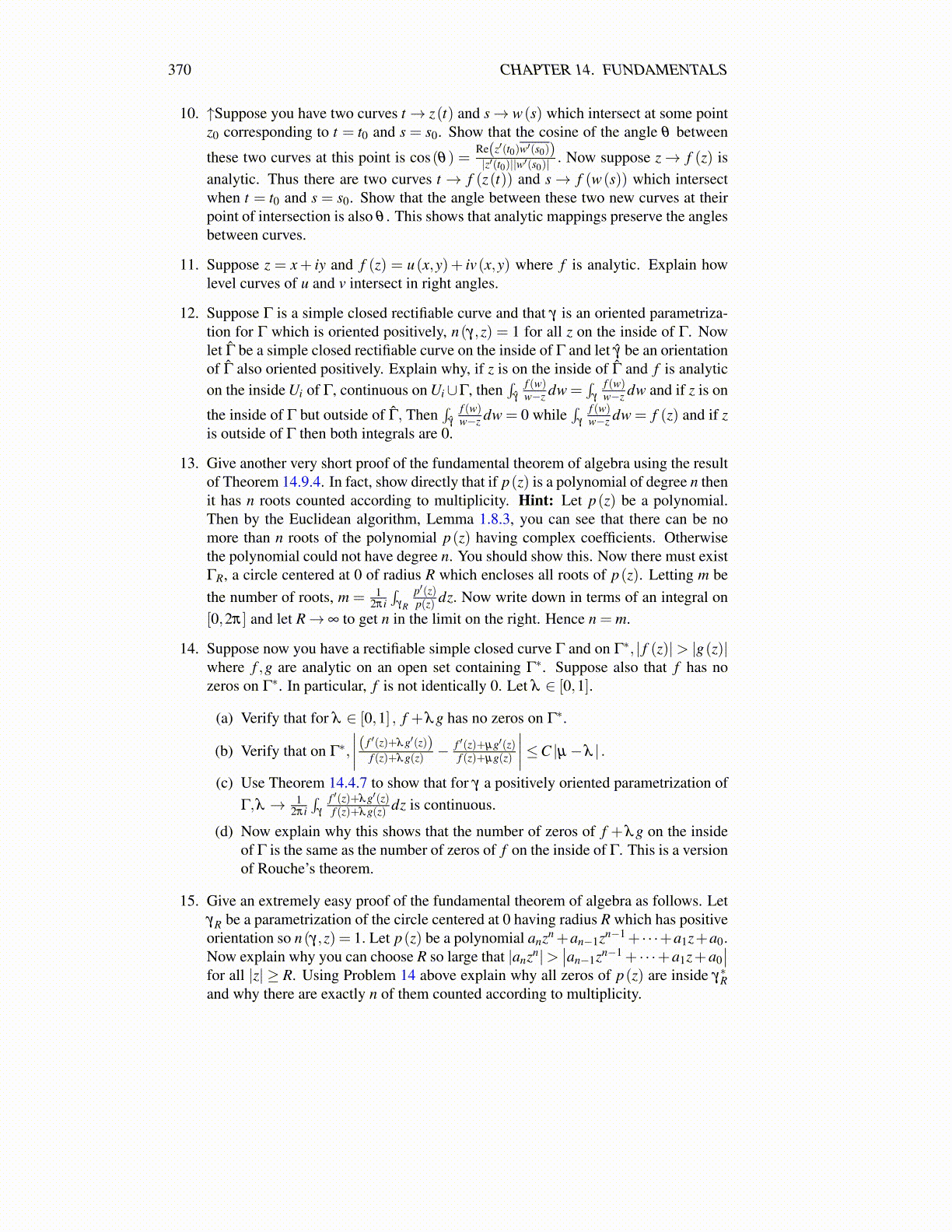
370 CHAPTER 14. FUNDAMENTALS
10. ↑Suppose you have two curves t→ z(t) and s→ w(s) which intersect at some pointz0 corresponding to t = t0 and s = s0. Show that the cosine of the angle θ between
these two curves at this point is cos(θ) =Re(z′(t0)w′(s0))|z′(t0)||w′(s0)|
. Now suppose z→ f (z) isanalytic. Thus there are two curves t → f (z(t)) and s→ f (w(s)) which intersectwhen t = t0 and s = s0. Show that the angle between these two new curves at theirpoint of intersection is also θ . This shows that analytic mappings preserve the anglesbetween curves.
11. Suppose z = x+ iy and f (z) = u(x,y)+ iv(x,y) where f is analytic. Explain howlevel curves of u and v intersect in right angles.
12. Suppose Γ is a simple closed rectifiable curve and that γ is an oriented parametriza-tion for Γ which is oriented positively, n(γ,z) = 1 for all z on the inside of Γ. Nowlet Γ̂ be a simple closed rectifiable curve on the inside of Γ and let γ̂ be an orientationof Γ̂ also oriented positively. Explain why, if z is on the inside of Γ̂ and f is analyticon the inside Ui of Γ, continuous on Ui∪Γ, then
∫γ̂
f (w)w−z dw =
∫γ
f (w)w−z dw and if z is on
the inside of Γ but outside of Γ̂, Then∫
γ̂
f (w)w−z dw = 0 while
∫γ
f (w)w−z dw = f (z) and if z
is outside of Γ then both integrals are 0.
13. Give another very short proof of the fundamental theorem of algebra using the resultof Theorem 14.9.4. In fact, show directly that if p(z) is a polynomial of degree n thenit has n roots counted according to multiplicity. Hint: Let p(z) be a polynomial.Then by the Euclidean algorithm, Lemma 1.8.3, you can see that there can be nomore than n roots of the polynomial p(z) having complex coefficients. Otherwisethe polynomial could not have degree n. You should show this. Now there must existΓR, a circle centered at 0 of radius R which encloses all roots of p(z). Letting m bethe number of roots, m = 1
2πi∫
γR
p′(z)p(z) dz. Now write down in terms of an integral on
[0,2π] and let R→ ∞ to get n in the limit on the right. Hence n = m.
14. Suppose now you have a rectifiable simple closed curve Γ and on Γ∗, | f (z)|> |g(z)|where f ,g are analytic on an open set containing Γ∗. Suppose also that f has nozeros on Γ∗. In particular, f is not identically 0. Let λ ∈ [0,1].
(a) Verify that for λ ∈ [0,1] , f +λg has no zeros on Γ∗.
(b) Verify that on Γ∗,
∣∣∣∣ ( f ′(z)+λg′(z))f (z)+λg(z) −
f ′(z)+µg′(z)f (z)+µg(z)
∣∣∣∣≤C |µ−λ | .
(c) Use Theorem 14.4.7 to show that for γ a positively oriented parametrization ofΓ,λ → 1
2πi∫
γ
f ′(z)+λg′(z)f (z)+λg(z) dz is continuous.
(d) Now explain why this shows that the number of zeros of f +λg on the insideof Γ is the same as the number of zeros of f on the inside of Γ. This is a versionof Rouche’s theorem.
15. Give an extremely easy proof of the fundamental theorem of algebra as follows. LetγR be a parametrization of the circle centered at 0 having radius R which has positiveorientation so n(γ,z) = 1. Let p(z) be a polynomial anzn+an−1zn−1+ · · ·+a1z+a0.Now explain why you can choose R so large that |anzn|>
∣∣an−1zn−1 + · · ·+a1z+a0∣∣
for all |z| ≥ R. Using Problem 14 above explain why all zeros of p(z) are inside γ∗Rand why there are exactly n of them counted according to multiplicity.